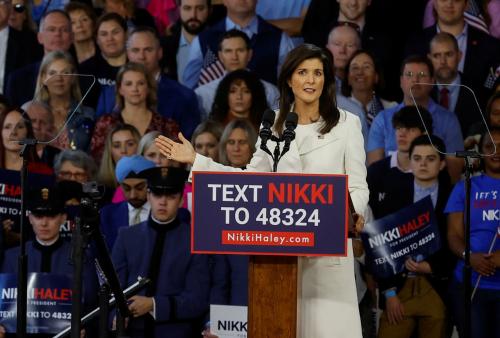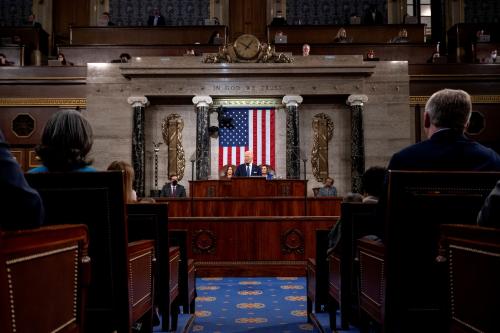Political scientists and forward-looking politicians have been debating the ultimate impact of the two youngest American generations — Plurals (Gen Z) and Millennials — on the nation’s partisan future for some time. With these two generations scheduled to become a majority of the American electorate later this decade, election results and a spate of recent data from Pew research are providing an increasingly persuasive answer. Younger voters should be a source of electoral strength for Democrats for some years to come.
Let’s start with the simple fact that, as Figure 1 illustrates, the Millennial generation is the largest generation in America today and the largest in American history.
FIGURE 1.
Population of Current U.S. Generations

As Figure 2 illustrates, Millennials and some of their younger siblings, will be a majority of the electorate in just six years.
FIGURE 2.
Millennials and Plurals Will Be a Majority of Potential Voters by 2028 — Over Sixty Percent by 2036

Research on individual voting behavior over time supports the idea that early partisan predilections persist over an individual’s life span. Republicans need to take steps now to reverse these trends among young people before they become an unbreakable barrier to GOP electoral success and Democrats need to focus on Plurals and Millennials in the years ahead to take advantage of the opportunity that this emerging majority presents.[1]
Younger Americans are tilting the electoral playing field strongly towards the Democrats and making it very likely that the “over/under” line in American politics will be 45, if not 50, for at least the rest of this decade.
For instance, the results of the 2022 midterm elections surprised many who didn’t believe the Harvard Institute of Politics (IOP) surveys that showed young people were very enthusiastic about voting in the 2022 midterms. Their influence enabled the Democrats to win almost every battleground statewide contest and increase their majority in the U.S. Senate, as illustrated in Figures 3 and 4.
FIGURE 3.
The 2022 Democratic Advantage Among Young Voters in Battleground States Allowed the Democrats to Recapture Senate Control

And even though the Democrats failed to retain their majority in the House of Representatives, the preference for Democratic candidates among members of the Pluralist and Millennial generations limited the size of the new Republican majority to just five votes.
FIGURE 4.
America’s Youngest Generations Voted Overwhelmingly Democratic for Congress in the 2022 Midterm Elections

What should be of even greater concern to Republicans is that this Democratic advantage, at least in the 2022 midterm election, was particularly strong among African American and Hispanic voters under the age of 45. Moreover, despite Republican efforts to make inroads in these communities and a large Republican vote among Hispanics in places like Florida, young minority voters supported Democrats by substantial margins. Eighteen to 29-year-old white voters also supported Democratic congressional candidates over Republican ones by a 58% to 40% margin, validating IOPs pre-election predictions as shown in Figure 5.
FIGURE 5.
The Democratic Advantage Among Young Voters Is True Among Key Racial and Ethnic Groups
Although the impact of Millennials’ and Plurals’ preferences for Democratic candidates among racial and ethnic voters varies based on congressional district lines and the nature of each’s state’s population, when it comes to voters under 45, and particularly among female voters of that age, their presence can be felt in every precinct in the country. See Figure 6.
FIGURE 6.
Young Female Voters Voted Overwhelmingly for Democrats in 2022

Linear projections of past trends are never definitive, especially in politics, and one election does not a trend make. But young people have now been voting solidly Democratic, and in increasing numbers, in every election since Donald Trump’s victory in 2016. In the 2018 midterm election, more than two thirds (68%) of voters under 45 cast ballots for Democratic congressional nominees and in 2020, 58% voted for President Biden.
The rising importance of the Millennial and Pluralist generation brings with it three challenges Republicans will need to deal with if they want to win national elections in the future.
First, younger voters overwhelmingly support the Democratic Party’s positions on issues like abortion and inclusion that Republicans have traditionally opposed. Even worse for the GOP’s future, a majority of younger Republican voters are closer to the Democratic Party’s positions on these cultural issues than they are to their own party’s posture. However, the Republican generational gap is not significant on economic issues. To take advantage of this potential opening with younger voters, the Republican Party would have to reverse their current emphasis on “wokeness” and pound away on the country’s economic unease instead. See Figure 7.[2]
FIGURE 7.
Younger and Older Republicans Diverge Significantly on Social Issues, Democrats Broadly United

Second, this divide by age on social issues within the Republican electorate is accompanied by a shrinking gender gap among younger voters, further unifying Democrats and making it harder for machismo-type Republican candidates to expand their appeal. Fifty-five percent of white male voters under 45 voted Democratic in 2022, as did 52% of younger white females. As Figure 8 illustrates, upwards of nine in ten male and female African American voters under 45 also voted Democratic in the midterms. Among both male and female Hispanics under 45, two-thirds voted for Democratic congressional candidates. To the extent that a gender gap still exists, in 2022 it is centered among older white and Hispanic voters. As Plural and Millennial voters become a larger and larger part of the American electorate, the gender gap in American politics is likely to shrink faster than the ozone layer.
FIGURE 8.
Democratic Advantage Among Plural and Millennial Voters Spread to All Racial and Ethnic Groups With Minimal Gender Gap

If those two challenges weren’t enough to deal with, Republicans reliance on broadcast media, such as Fox News and talk radio, means their message isn’t even being heard by Plurals and Millennials who live in an entirely different information ecosystem, built around social media, especially TikTok and YouTube.[3] Figure 9 shows how different younger voters are when it comes to trust in media.
FIGURE 9.
Reaching Younger Voters Requires Using Social Media (Plurals and Millennials Prefer To Use Digital To Get News and Trust It More as a News Source)

Of course, the Democratic party is not without its own challenges in adapting their strategies to an electorate dominated by younger voters. Older, embedded media commentators, pollsters, and campaign consultants, who make up the Democratic “permanent campaign complex,” are often slow to learn new tricks and less familiar with how to communicate with younger voters using their preferred platforms to talk about their policy priorities. For example, even in 2022, Democratic candidates for Senate in swing states such as Colorado and Ohio, recoiled in horror from President Biden’s proposal to forgive a portion of the two generations’ student debts, even though one of younger voters’ top priorities is making college more affordable, if not tuition free — ranking right up there with preserving reproductive rights and dealing with climate change.
If Democrats don’t run campaigns that focus on voters under 45, wherever they live and whatever their current political preferences, they could not only lose their chance for a sweeping victory in 2024 but potentially lose the allegiance of the large and growing majority of American voters for decades to come.
Footnotes
[1] The landmark 1950’s analysis of political behavior, The American Voter, indicated that upwards of nine in ten American adults identified with or leaned to one of the major US political parties. For the large majority, this identification was formed when they were young adults and remained constant throughout their life. (Campbell, et. al. 1960. The American Voter. New York: Wiley). In a replication of the original work, The American Voter Revisited, researchers interviewed a panel of respondents at four different points in time over a seventeen-year period (1965-1982). In that research more than eight in ten Americans identified with or leaned to one of the parties and upward of eight in ten identified with the same party at the end of the period that they did at the beginning. More recently, in 2000 and 2004, a similar panel showed an equivalent level of party identification and stability in that identification over time. (Lewis-Beck, et. al. 2008. The American Voter Revisited. Ann Arbor: University of Michigan Press).
[2] Pew respondents were asked to indicate which of 2 statements came closer to their own views. The statements were: “America’s openness to people from all over the world is essential to who we are as a nation” as opposed to “If America is too open to people from all over the world, we risk losing our identity as a nation.” The figures on the graph represent those who chose the first statement. For the second, respondents were presented with the following statement: “In general, how much do White people benefit from advantages in society that Black people do not have.” The bars on the graph represent those who indicated “A great deal” or “A fair amount” in response to that statement. For the third, the procedure was similar to that of the first set of bars. Respondents were asked to indicate which of two statements came closest to their own views. The statements were: “The obstacles that once made it harder for women than men to get ahead are now largely gone” as opposed to “There are significant obstacles that make it harder for women to get ahead than men.” The figures on the graph represent those who chose the second statement.
[3] According to Nielsen ratings “More than half of the Fox News Audience is older than 65.”
The Brookings Institution is committed to quality, independence, and impact.
We are supported by a diverse array of funders. In line with our values and policies, each Brookings publication represents the sole views of its author(s).









Commentary
How younger voters will impact elections: Younger voters are poised to upend American politics
February 27, 2023